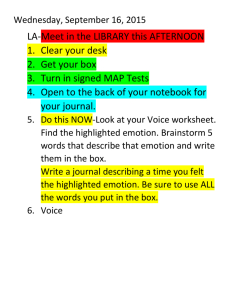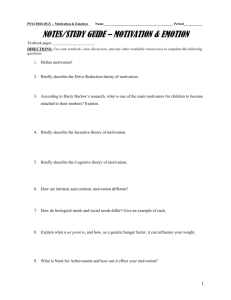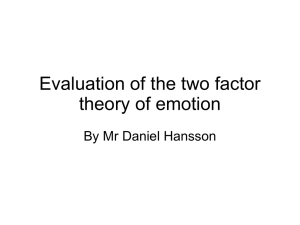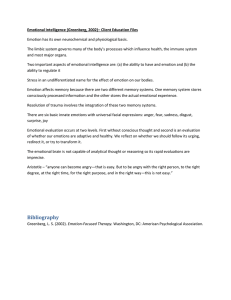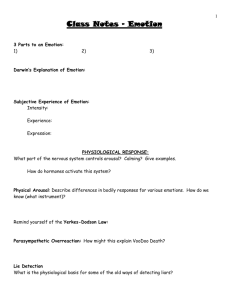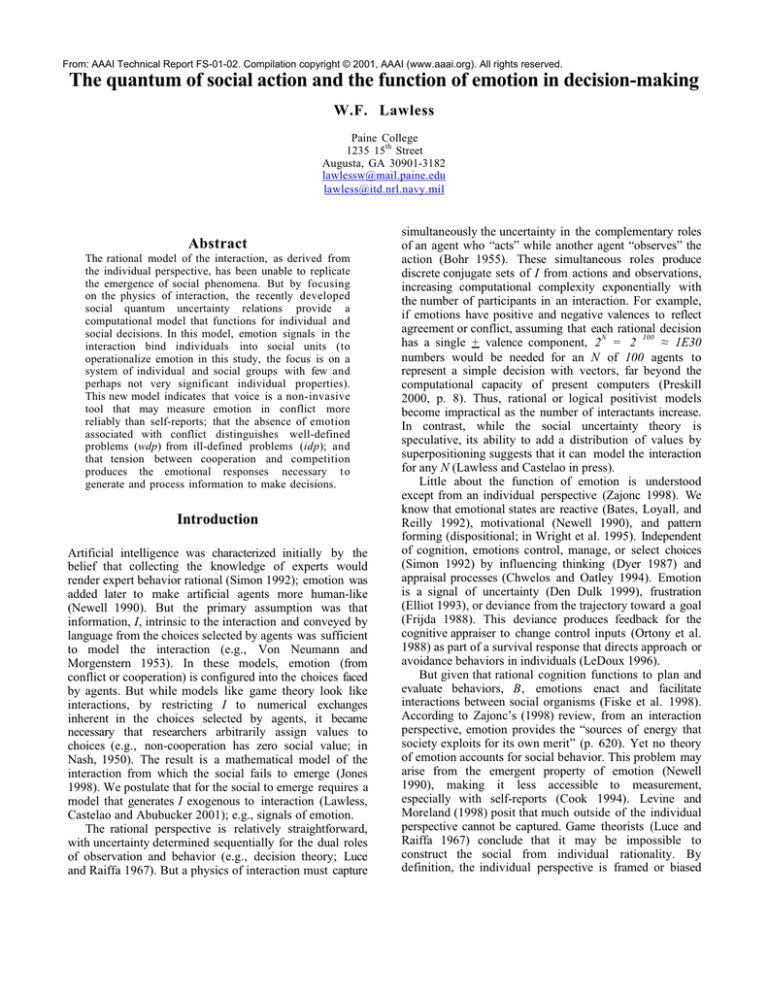
From: AAAI Technical Report FS-01-02. Compilation copyright © 2001, AAAI (www.aaai.org). All rights reserved.
The quantum of social action and the function of emotion in decision-making
W.F. Lawless
Paine College
1235 15th Street
Augusta, GA 30901-3182
lawlessw@mail.paine.edu
lawless@itd.nrl.navy.mil
Abstract
The rational model of the interaction, as derived from
the individual perspective, has been unable to replicate
the emergence of social phenomena. But by focusing
on the physics of interaction, the recently developed
social quantum uncertainty relations provide a
computational model that functions for individual and
social decisions. In this model, emotion signals in the
interaction bind individuals into social units (to
operationalize emotion in this study, the focus is on a
system of individual and social groups with few and
perhaps not very significant individual properties).
This new model indicates that voice is a non-invasive
tool that may measure emotion in conflict more
reliably than self-reports; that the absence of emotion
associated with conflict distinguishes well-defined
problems (wdp) from ill-defined problems (idp); and
that tension between cooperation and competition
produces the emotional responses necessary t o
generate and process information to make decisions.
Introduction
Artificial intelligence was characterized initially by the
belief that collecting the knowledge of experts would
render expert behavior rational (Simon 1992); emotion was
added later to make artificial agents more human-like
(Newell 1990). But the primary assumption was that
information, I, intrinsic to the interaction and conveyed by
language from the choices selected by agents was sufficient
to model the interaction (e.g., Von Neumann and
Morgenstern 1953). In these models, emotion (from
conflict or cooperation) is configured into the choices faced
by agents. But while models like game theory look like
interactions, by restricting I to numerical exchanges
inherent in the choices selected by agents, it became
necessary that researchers arbitrarily assign values to
choices (e.g., non-cooperation has zero social value; in
Nash, 1950). The result is a mathematical model of the
interaction from which the social fails to emerge (Jones
1998). We postulate that for the social to emerge requires a
model that generates I exogenous to interaction (Lawless,
Castelao and Abubucker 2001); e.g., signals of emotion.
The rational perspective is relatively straightforward,
with uncertainty determined sequentially for the dual roles
of observation and behavior (e.g., decision theory; Luce
and Raiffa 1967). But a physics of interaction must capture
simultaneously the uncertainty in the complementary roles
of an agent who “acts” while another agent “observes” the
action (Bohr 1955). These simultaneous roles produce
discrete conjugate sets of I from actions and observations,
increasing computational complexity exponentially with
the number of participants in an interaction. For example,
if emotions have positive and negative valences to reflect
agreement or conflict, assuming that each rational decision
N
100
≈ 1E30
has a single + valence component, 2 = 2
numbers would be needed for an N of 100 agents to
represent a simple decision with vectors, far beyond the
computational capacity of present computers (Preskill
2000, p. 8). Thus, rational or logical positivist models
become impractical as the number of interactants increase.
In contrast, while the social uncertainty theory is
speculative, its ability to add a distribution of values by
superpositioning suggests that it can model the interaction
for any N (Lawless and Castelao in press).
Little about the function of emotion is understood
except from an individual perspective (Zajonc 1998). We
know that emotional states are reactive (Bates, Loyall, and
Reilly 1992), motivational (Newell 1990), and pattern
forming (dispositional; in Wright et al. 1995). Independent
of cognition, emotions control, manage, or select choices
(Simon 1992) by influencing thinking (Dyer 1987) and
appraisal processes (Chwelos and Oatley 1994). Emotion
is a signal of uncertainty (Den Dulk 1999), frustration
(Elliot 1993), or deviance from the trajectory toward a goal
(Frijda 1988). This deviance produces feedback for the
cognitive appraiser to change control inputs (Ortony et al.
1988) as part of a survival response that directs approach or
avoidance behaviors in individuals (LeDoux 1996).
But given that rational cognition functions to plan and
evaluate behaviors, B, emotions enact and facilitate
interactions between social organisms (Fiske et al. 1998).
According to Zajonc’s (1998) review, from an interaction
perspective, emotion provides the “sources of energy that
society exploits for its own merit” (p. 620). Yet no theory
of emotion accounts for social behavior. This problem may
arise from the emergent property of emotion (Newell
1990), making it less accessible to measurement,
especially with self-reports (Cook 1994). Levine and
Moreland (1998) posit that much outside of the individual
perspective cannot be captured. Game theorists (Luce and
Raiffa 1967) conclude that it may be impossible to
construct the social from individual rationality. By
definition, the individual perspective is framed or biased
by its “worldview” (Linton 1957), making it unrealistic as
a model of social behavior (e.g., Arrow 1951).
Yet traditional models of multiple autonomous agent
systems (MAS) employ variations of set logic that
continue to verify classical De Morgan laws (Tessier et al.
2001). This path remains within well-formed formulas for
distributive lattice logical frameworks (dllf) that assure
classification while avoiding contradiction and tautology.
But the conflict found in nature differs from formal logic
and its essential feature of contradiction. Given P1 and P2
as mutually exclusive propositions, conflict (i.e., >< )
occurs when P1 > < P2 ↔ P1 ∩ P2 = 0. For a dllf, this
happens for a complemented lattice given P1 = ¬P2 and P1
∪ P2 = 1, the difference being that these conditions are not
necessary for conflicts in nature. To better represent nature,
Tessier and her colleagues (see p. 24-26) propose a model
of “conflict-adapted negation” that weakens negation with
orthogonal operators in weak lattices to constitute the
research path forward. An alternative path follows quantum
logic adapted to the mechanisms underlying interaction
and the evolution of conflict, with emotion linking
individual with social behavior to stabilize the interaction,
establish interaction channels, and build social structures
(Lawless, Castelao and Abubucker 2001).
Structures standardize cooperative interactions; e.g.,
greetings, religious rituals, or barter. Interaction requires
energy, E; with k∂2E/∂x2 ≈ c∆E and k,c as constants,
minimum E loss gives:
∆ E ≈ 0,
(1)
i.e., structures minimize E uncertainty; e.g., technology,
like language or money, reduces E consumption (Ambrose
2001). Equation (1) represents resonance (e.g., vocal
resonance). Linking individual and social behavior,
resonance between interactants occurs under maximum
agreement, minimum conflict, and least E expenditures
(Lawless and Castelao in press).
Equation (1) can be re-derived from the interaction
uncertainty relations and qualitatively from information
theory (Lawless, Castelao, and Ballas 2000). For the first
re-derivation, assuming that action and observation are
controlled by interdependent cognitive systems (Rees et al.
1997), with action, ∆a, and observational uncertainty, ∆I,
the interdependent uncertainty relations become
∆a∆I ≈ c.
(2)
Not knowing c, the quantum of social action, a
solution requires boundary conditions: e.g., as ∆I -> 0, ∆a
-> ∞: The more certain the information derived from an
interaction by an individual or group (e.g., ideology), the
less I it has about its own actions or those of others
(Baumeister 1995). Support came from an experiment
with Air Force combat pilots when air combat performance
was found not to be associated with scores from a written
examination of air combat maneuvers (Lawless, Castelao,
and Ballas 2000). Regarding emotion, speakers are less
aware than listeners of emotion conveyed (Zajonc 1998, p.
612); correlations between autonomic nervous systems and
subjective reports are weak (Zajonc, 1998 p. 612); and
Moreland and Zajonc (1977) found that emotion from mere
exposure of stimuli does not correlate with self-reports.
The biases in self-reports derive from a function of
worldviews to reduce the uncertainty associated with
reality, R (Rosenblat et al. 1990). If worldviews are
composed of arbitrary (e.g., culture, ritual, or religion) and
functional components (e.g., hunting, engineering,
medicine) (Ambrose 2001); if worldviews are bistable in
the sense that the mind can focus on only one view of R at
a time (Cacioppo, Berntson, and Crites 1996); if the
expression and measurement of self-interest is guided by
culture (Wright 2000); if social influence is inversely
related to distance between cultural sources (Latane 1981);
and if each worldview, including science, underdetermines
R (Feynman 1963), multiple cultures ensue (Bohr 1955).
Consequently, self-reported events become framed by
worldviews guided by self-interests. With conflict or
competition over scarce resources, these biases can become
incommensurable barriers between cultures (ideology);
e.g., from a 1999 Public Opinion Strategies Poll,
"Republicans, by 45% to 17%, think the Clintonesque
movie "Primary Colors" is more truth than fiction;
Democrats, 40% to 23% think the opposite".
Reversing boundary conditions for Equation (2) is
counterintuitive: as ∆I -> ∞, ∆a -> 0; i.e., the solution to
an ill-defined problem (idp) occurs by bringing
incommensurable viewpoints together before neutral
observers to reduce the certainty in each belief,
contradicting Nash (1950). This prediction occurs
surprisingly often: courtroom conflict between adversarial
interests, opposing viewpoints in scientific journals, and
foils in the theater to illuminate character. From a field
study, a comparison of environmental remediation
decisions at the Department of Energy’s Savannah River
Site in South Carolina versus its Hanford Site in
Washington, and the Citizen Advisory Boards at both sites
(SAB and HAB, respectively), indicated that competition
between opposing viewpoints led to better environmental
results than cooperation under consensus rules to promote
a single worldview (Lawless, Castelao, and Ballas 2000).
Letting a equal the rate of information change, ∆I/∆t,
and j the inertia of reacting to information change gives the
uncertainty relations for energy, E, and time, t:
∆a∆I = ∆ (∆I/∆t) * ∆I * ∆t/∆t =
2
(3)
j * ∆ (∆I/∆t) * ∆t = ∆E∆t ≈ c.
As ∆t -> 0, then ∆E -> ∞. This occurs as time sequencing
becomes important. For example, the more celebrated a
court case, the more important become issues of timing
and the more uncertain become expenditures of E to
prosecute or defend the case. In the two examples above
(Lawless, Castelao, and Ballas 2000), the E expended by
HAB to construct a consensus worldview was significantly
greater than by SAB to reach its decisions with majority
rule; and in the USAF study, the more E wasted by a pilot
in air combat, the less successful he was.
As ∆t -> ∞, ∆E -> 0, reproducing Equation (1); e.g.,
resonance in the voice box provides unlimited vocalization
(∆t -> ∞) with minimum E (Ladefoged 1996). Interaction
resonance characterizes an organism, group, or system
minimizing its marginal expenditures of E.
A recent example of E minimization comes from the
Wall Street Journal: Despite a head start and extraordinary
public financing given to the Human Genome Project by
the National Institutes of Health (NIH), the private
corporation Celera decoded the human genome first,
winning patents and rich fees. Compared to NIH’s “free”
product, Celera’s was more complete, had fewer mistakes,
and has saved scientists effort in their discovery of new
products; since then, NIH has become a client.
For the second re-derivation of Equation (1), xi as agent
i and I(x1,x2) as joint entropy gives:
I(x1,x2) = I(x1) + Ix1(x2).
(4)
From Equation (4), I(x1,x2) is minimum when x1 and x2
cooperate, and maximum when both are independent. The I
transmitted between them, IT, is
IT(x1:x2) = I(x1) + I(x2) - I(x1,x2)
= I(x2) - Ix1(x2),
(5)
indicating communication is minimum for independent
agents and maximum under cooperation. Less I is available
to witnesses when interaction partners cooperate,
promoting deception, while competition produces more I
for external witnesses, constraining corruption.
As a test, given free energy, ∆A,
-∆A = ∆E – T∆I.
(6)
When ∆E/∆I > 1, energy is available for competition to
create new structures or technology; but when ∆E/∆I is <
1, cooperative systems are more successful. In support, we
found significant and positive correlations between
competition, E consumption, scientific knowledge (∆I ->
0), human health, and less corruption (Lawless and
Castelao in press). And the more economically competitive
a nation, the more cooperative it can be in addressing
environmental disasters. Similarly, deteriorating economic
conditions or increasing competition increase teamwork
and business mergers.
Finally, qualitatively reproducing Equation (1), as
opposing core beliefs of an agent enter its awareness,
cognitive dissonance and anxiety occur until the agent
selects one belief over the other (thereby shifting from
cognitive independence of beliefs to cognitive consonance;
in Lawless, Castelao and Abubucker 2001). Remarkably,
this effect is self-similar (fractal) for the path from social
conflict to compromise by social decision-makers.
But as part of the path forward, Equations (4) and (5)
fail to tell us critical information. All things being equal,
cooperation requires less E than competition. Yet the
evidence cited for DOE and the USAF indicates that under
competition, marginal expenditures of energy, dE/dt, are
less under competition. Other evidence provides indirect
support. While wealth is associated with increasing
population size (Wright 2000) and while regional
governments expend less E than central governments
(Weiss and Bradley 2001), wealthier nations and families
have lower birth rates and are more E efficient (Leone and
Potter 1988), and, from the example of Celera, new
technology directly reduces marginal E expenditures. Also,
Latane (1981) discovered that cooperation among team
members invariably produced less than the sum of the peak
performances from each of the individuals comprising a
team (”social loafing”).
Marginal expenditures of E reflect self-interests. As
resources become limited, individual survival responses are
expressed in social interests (Dawkins 2000, p. 442); e.g.,
the more advanced a technology, the more hierarchical the
processes for assembly (Ambrose 2001). But cooperation
between groups reduces I and promotes deception
(Lawless, Castelao and Abubucker 2001); conversely,
competition increases I and promotes creativity.
It may be that cooperation is inefficient the more a
structure shifts from resonance between interactants (e.g.,
bureaucracy); that within
cooperative structures,
competition is self-defeating, as is private collusion or
public compromise between competitors. Thus, tension
between cooperation and competition optimizes social
behavior (Lawless and Abubucker 2001).
Social temperature and emotional arousal
One way to study tension is to link temperature, T, with
emotional or social activation; e.g., as physical T
increases, social violence increases (Anderson 2001). But
no clear link exists between T in physical and social
systems. However, T could represent the average activation
experienced in a social I field, e.g., the greater the
dissonance, the higher is T. Thus, activation breaks down
social structure. Given T = ∂E/∂I, the greater the
activation, T, the more E is consumed to produce or
process each unit of I. At the individual level, findings
agree that as conflict (dissonance) increases, brain T
increases (Zajonc 1998, p. 606, 616); the lower is
expertise, the greater the emotional activation observed to
process each unit of I (Landers and Pirozzolo 1990); and
compared to hearing subjects, deaf subjects responded to
speech with an order of magnitude more of non-verbal
reactions (Zajonc 1998, p. 619). Finally, the greater the
social status of an individual, the lower is pitch (Zajonc
1998, p. 606, 620); regular and angry voices can be
distinguished (Kang and Everett 1984); and Kang (personal
communication) recently found that the E expressed in
anger is greater than for normal voice.
To model social T (see Figure 1) given kB as
Boltzman’s constant (Hertz et al. 1991, p. 276), the
strength, f(E), of an interaction structure to channel I from
interactions becomes
f(E) = 1/(1 + exp(-2E/kBT)).
(7)
Equation 7 indicates that as T drops, the I channeled from
interactions becomes more stable and measurable, and the
less competitive and more resistant to change becomes a
culture. Conversely, as T increases, I channeled by
interaction structures becomes random, causing channels to
fail and social cohesion to dissipate, agreeing with
Schumpeters’ (1989) idea of the creative destruction that
occurs from competition.
V
f(E)
V
E1
E
E
0
V0
Decreasing T
Figure 1. The relation for strength of a structure, f(E), T, and E.
Emotion and cognition (Work in progress)
From his review of emotion, Zajonc (1998, p. 597-8)
concluded that emotion had primacy over cognition. It
takes around 150 ms to identify stimuli (Zajonc 1998, p.
604); but the mere exposure of stimuli becomes associated
with emotional responses around 4 ms (Zajonc 1998, p.
618). Yet Zajonc concluded that the interaction between
emotion and cognition remains unknown.
The tension from dissonance implies that emotions
may be linked to cognitive states by a mechanism like set
point theory (SPT). Physiologically, SPT suggests that
equilibrium points exist for the intake of food (see Bennett
and Gurin 1982). Diener and Oishi (2000) extended SPT
to life satisfaction levels. By studying events like winning
the lottery or suffering personal loss, which common
wisdom associates with happiness or suffering, they found
instead that life satisfaction quickly returns to pre-event
levels. Thus, SPT may account for the stable reactance to
social change we defined as information inertia, j.
Social loafing suggests that the members of a group are
seeking the minimum E state to satisfy self-interest. This
explains why game theory, which does not consider E
formally (except as costs or time), cannot determine
whether groups are more or less efficacious than the sum of
the individual members who constitute the group (e.g.,
contrast Von Neumann and Morgenstern 1953, p. 275,
with Luce and Raiffa 1967, p. 193).
To apply SPT to decision-making, assume that a stable
cognition endorsed by an agent exists in a low E and T
state (e.g., resolved cognitive dissonance). Next assume
that adopting a new cognitive belief or skill requires the
increased expenditure of E (e.g., Landers and Pirozzolo
1990). As E is increased above baseline, T increases and
emotion set points activate to keep cognitive
representations from changing, holding them in a square
energy well, triggering a return to cognitive stability.
Control would be employed in a similar manner. Thus,
given the opportunity to freely consume food, eating a
stable quantity each day is governed by set points that
increase intake above a certain level and decrease it below
another level (see Figure 2).
Figure 2. A square-well representation of energy (E0 i s
baseline) associated with a rational belief and its emotional
potential energy (V0 is 0). As a cognitive representation gains
E to redefine its meaning, emotional potential energy, V,
repels the change, keeping the belief stable.
The advantages of the square-well model:
1.
2.
3.
4.
5.
6.
7.
It is mathematically tractable. The Schrodinger
wave equation can be employed, producing a
stationary state (emotional stability; individual
observations) and a time-dependent state for I
flow (e.g., emotion during conflict). Shallow
square wells produce more easily observed effects
than deeper wells, agreeing with the evidence that
the brains of experts appear “cooler” than novices
performing similar tasks (Landers and Pirozzolo
1990).
Superposition of different emotional states occurs
from adding different solutions of the social
quantum equations in item 1, producing new
solutions. Zajonc reports emotional states are
additive (Zajonc 1998, p. 618; e.g., Zillman’s
excitation transfer effect).
It offers a new rational approach to the interaction
between emotion and cognition.
It indicates that different levels of emotion can be
studied in natural settings with voice (e.g.,
resonance) instead of self-reports, which have
proved unreliable.
It paves the way for a value-free theory of
decision-making; instead, cooperation and
competition both become important, rejecting the
traditional model which designates cooperation as
a superior social good (e.g., Axelrod 1984).
It indicates that combining the incommensurable
processes of cooperation and competition in
decision making is similar to the orthogonal I
processing in quantum computation (Tessier et al.
2001).
To illustrate the square-well model with social
decisions, cooperation reduces social activation T
and reflect social stability (a deeper well), while
competition increases social activation T to
overcome stability. During the solution of an illdefined problem (idp), competition increases T to
overcome the emotional barriers from stable states
of cooperation. Once a problem is solved and
becomes well-defined (wdp), T reduces, allowing
a new social structure to be built with potential
energy, V new . In this model, emotional agitation
(e.g., from conflict) illuminates the link between
individual and social behavior.
Conclusions
The thesis of logical positivism is that perfect knowledge
builds consensuses, ending the need for conflict (e.g,
Shearer and Gould 1999), encouraging researchers to make
value judgments about I (e.g., Wright 2000). But social
effects fail to emerge from traditional rational models of
the interaction. And after nearly 60 years of research, game
theory has not been validated in the laboratory (Kelley
1992) or the field (Jones 1998), nor has decision theory
(Klein 1997; Shafir, Simonson and Tversky 1993). This
situation arises from ignoring the physics of interaction.
First, the logical positivist model overlooks the E invested
in the structures that produce social stability (Luce 1997).
Recent news items illustrate that when established
structures are threatened, tension or conflict is a common
response: the issue of barring ordination based on sexual
orientation has bitterly divided Protestant denominations
in the U.S.; and in Russia, fights broke out in the State
Duma voting to permit the sale and purchase of private
property. In science, tension is “essential” to discovery
(Kuhn 1977).
Second, conflict generates information. Both of these
shortcomings are addressed with interaction uncertainty
relations (Equations 2 and 3). Instead of a focus on I
intrinsic to the interaction, it considers the physics of I
exogenous to the interaction (see Von Neuman and
Morgenstern 1953, pp. 147-8, for a similar concern). The
social quantum uncertainty relations are tractable
mathematically, and they make strong connections between
interaction concepts and reality, which Kuhn (1970)
considers to be rare. If emotion is the critical ingredient
that stabilizes the interaction, from which emerges social
behavior, emotions are derived directly from the
mathematics of the social quantum uncertainty relations.
They suggest new measures of the interaction, including
voice, may act as a surrogate measure of problem
complexity when measures of communication density are
included. In sum, the social uncertainty relations provide a
step forward with theory and field research by laying a
foundation for a physics of social interaction that offers a
new and rational means to control autonomous agents.
Acknowledgements. The author thanks J.A. Ballas and G.
Kang, ITD, Naval Research Laboratory, Washington, DC,
where most of this research was conducted with funds from
the Office of Naval Research through an American Society
Engineering Education grant.
References
Ambrose, S.H. (2001), Paleolithic technology and human
evolution, Science, 291, 1748-53.
Anderson, C. (2001), Heat and violence, Current
directions in psychological science, 10(10), 33-38.
Arrow, K.J. (1951), Social choice and individual values,
Cowles Communication Monograph 12, New York:
Wiley.
Axelrod, R. (1984), The evolution of cooperation. New
York: Basic.
Bates, J., Loyall, A.B., and Reilly, W.S. (1992),
Integrating reactivity, goals, and emotion in a broad
agent, In the Proceedings of the 14th Annual Meeting
of the Cognitive Science Society.
Baumeister, R.F. (1995), Advanced Social Psychology, pp.
51-97, New York: McGraw-Hill.
Bennett, W. and Gurin, J. (1982), The dieter’s dilemma:
Eating less and weighing more, New York: Basic.
Bohr, N. (1955), Science and the unity of knowledge, In
L. Leary (ed.), The unity of knowledge, pp. 44-62,
New York: Doubleday.
Cacioppo, J.T., Berntson, G.G. and Crites, S.L., Jr.
(1996), Social neuroscience: Princ. psychophysio.
arousal and response, In E.T. Higgins and A.W.
Kruglanski, Social Psychology Handbook of Basic
Principles, New York: Guilford.
Chwelos, G. and Oatley, K. (1994), Appraisal,
computational models, and Scherer’s Expert System,
Cognition and Emotion, 8(3), 245-257.
Cook, T.D. (1994), Social psychology and science studies,
In W.R. Shadish and S. Fuller, The social
psychology of science, pp. 364-389, New York:
Guilford.
Dawkins, R. (2000), Unweaving the Rainbow: Science,
Delusion and the Appetite for Wonder, New York:
Houghton Mufflin Company.
Den Dulk, P., Rokers, B., and Phaf, R. H. (1999).
Connectionist simulations with a dual route model
of fear conditioning. In B. Kokinov (Ed.),
Perspectives on Cognitive Science (Vol. 4, pp. 102112). Sofia: New Bulgarian University.
Diener, E. and Oishi, S. (2000), Money and happiness:
Income and subjective well-being across nations, in
E. Diener and E. Suh (Eds.), Culture and subjective
well-being, pp. 185-218, Cambridge: MIT.
Dyer, M. (1987), Emotions and their computations: Three
computer models, Cognition and Emotion, 1(3),
323-347.
Elliot, C. (1993), Variables Influencing the Intensity of
Simulated Affective States; presented at AAAI
Spring Symposium on Mental States 93.
Fiske, A.P., Kitayama, S., Markus, H.R., and Nisbett,
R.E. (1998), The cultural matrix of social
psychology, In Gilbert, D.T., Fiske, S.T., and
Lindzey, G., The Handbook of Social Psychology,
pp. 915-981, Boston: McGraw-Hill.
Feynman, R. (1967), The character of physical law,
Cambridge: MIT Press.
Frijda, N.H. (1988). The laws of emotion. American
Psychologist, 43, 349-358.
Hertz, J., Krogh, A., and Palmer, R.G. (1991),
Introduction to neural computation, Redwood City,
CA: Add.-Wesley.
Jones, E.E. (1998), Major developments in five decades
of soc psych, In Gilbert, D.T., Fiske, S.T., and
Lindzey, G., The Handbook of Social Psychology,
Vol. I, pp. 3-57. Boston: McGraw.
Kang, G.S. (2001). Personal communication, Naval
Research Lab.
Kang, G.S. and Everett, S.S. (1984), Improvement
narrowband linear predictive coder, Part 2, Naval
Res. Lab. Rpt 8799, Washington, DC.
Kelley, H.H.
(1992). Lewin,
situations,
and
interdependence. Journal of Social Issues, 47, 211233.
Klein, G. (1997), Overview, In C.E. Zsambok and G.
Klein (Eds.), Naturalistic decision making, pp. 4959. Mahwah, NJ: Lawrence Erlbaum.
Kuhn, T. (1970), The structure of scientific revolutions
(2nd Ed.), Chicago: U. Chicago Press.
Kuhn, T. (1977), The essential tension, Chicago: U.
Chicago Press.
Ladefoged, P. (1996), Elements of acoustic phonetics.
Chicago: University of Chicago Press [original
version published in 1962].
Landers, D.M., and Pirozzolo, F.J. (1990), Panel
discussion:
Techniques for enhancing human
performance (NAS Report), Ann. mtg American
Psychological Assn, Boston, MA.
Latane, B. (1981), The psychology of social impact,
American Psychologist, 36, 343-356.
Lawless, W.F. and Castelao, T. (in press), The university
between technology and society: Bridge or Decision
Center? IEEE Technology and Society.
Lawless, W.F., Castelao, T., and Ballas, J.A. (2000),
Virtual knowl: Bistable reality and the solution of
ill-defined problems, IEEE Systems Man, and
Cybernetics, 30(1), 119-126.
Lawless, W.F., Castelao, T., and Abubucker, C.P. (2001),
Conflict as a heuristic in the development of an
interaction mechanics, in C. Tessier, L. Chaudron,
and H.J. Muller, Conflicting agents: Conflict
management in multi-agent systems, pp. 279-302,
Boston: Kluwer.
Lawless, W.F. and Abubucker, C.P. (2001, May 10). The
principle of least information: Emotion, stability,
and change. Proceedings, Onera-Cert, Toulouse, Fr.
LeDoux J.E. (1996), The Emotional Brain, New York:
Simon and Schuster.
Leone, M.P., and Potter, P.B., Jr. (1988). The Recovery of
Meaning. Historical Archaeology in the Eastern
United States. Washington, DC: Smithsonian
Institution Press.
Levine, J.M. and Moreland, R.L. (1977), Small groups, In
Gilbert, Fiske, and Lindzey, Handbook of Social
Psychology, vol. II, pp. 415-469.
Linton, R. (1957). The tree of culture, New York:
Knopf.
Luce, R.D. and Raiffa, H. (1967), Games and decision,
New York: Wiley.
Moreland, R.L. and Zajonc, R.B. (1998), Exposure effects
may not depend on stimulus recognition, J.
Personality and Social Psychology, 37, 1085-89.
Nash, J.F., Jr. (1950), The bargaining problem,
Econometrica, 18, 155-162.
Newell, A. (1990), Unified theories of cognition,
Cambridge: Harvard.
Nowak, M.A., Page, K.M., Sigmund, K. (2000), Fairness
versus reason in the ultimate game, Science, 289,
1773-5.
Ortony, A., Clore, G.L., and Collins, A. (1988), The
cognitive structure of emotions, New York:
Cambridge.
Preskill, J. (2000), Quantum computation, www.
theory.caltech.edu/people/preskill/.
Rees, G., Frackowiak, R., and Frith, C. (1997). Two
modulatory effects of attention that mediate object
categorization in human cortex., Science, 275, 835-8.
Rosenblatt, A., Greenberg, J., Solomon, S., Pyszczynski,
T., and Lyon, D. (1990), Evidence for terror
management theroy, J. Personality and Social
Psychology, 57, 681-690.
Schumpeter, J.A. (1989), A theoretical, historical, and
statistical analysis of the capitalist process,
Porcupine Press.
Shafir, E., Simonson, I. and Tversky, A. (1993),
Cognition, 49, 11-36.
Shearer, R.R. and Gould, S.J. (1999), Essay on science
and society: Of two minds and one nature, Science,
286, 109-110.
Simon, H.A. (1992), What is an explanation of behavior?,
Psychological Science, 3, 150-161.
Tessier, C., Muller, H-J, Fiorino, H., and Chaudron, L.
(2001), Agents’ conflicts: new issues, in C. Tessier,
L. Chaudron, and H.J. Muller, Conflicting agents,
pp. 1-30, Boston: Kluwer.
Von Neumann, J. and Morgenstern, O. (1953), Theory of
games and economic behavior, Princeton: Princeton
University Press.
Weiss, H. and Bradley, R.S. (2001), What drives societal
collapse?, Science, 291, 609-10.
Wright, R. (2000), Nonzero. The logic of human destiny,
New York: Pantheon.
Wright, I., Sloman, A., and Beaudoin, L. (1995), Towards
a Design-Based Analysis of Emotional Episodes
(www.cs.bham.ac.uk/~axs/cog_affect/Wright_Sloman
_Beaudoin_grief)
Zajonc, R.B. (1998), Emotion, In Gilbert, D.T., Fiske,
S.T., and Lindzey, G., The Handbook of Social
Psychology, Boston: McGraw-Hill.

